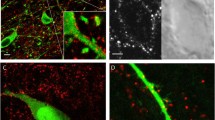Abstract
The dopamine D2 receptor and D3 receptor (D2R, D3R) have high homology in both their amino acid composition and signaling pathways. Virtually all signaling pathways reported thus far overlap between the two receptors with the exception that the D3R signals are 2∼5 times less efficient than D2R. Previous studies have suggested that conformational constraints of D3R might be responsible for the poor coupling with the G protein. To this hypothesis, point mutations were introduced into some of the conserved regions between D2R and D3R, and their effects on receptor expression were investigated. Among the four conserved intracellular receptor regions examined (TTT motif in the 1st intracellular loop, SS motif in the 2nd intracellular loop, YxxL and TxxS/xS motifs in the 3rd intracellular loop), a mutation of the Thr-Thr-Thr (TTT) motif in the first intracellular loop or the LxxY motif in the 3rd intracellular loop markedly decreased the level of D3R expression compared with D2R. The TTT motif was further mutated individually or in combination to test which residue plays a critical role on the expression of the receptor proteins. Different amino acids between D2R and D3R in the 1st intracellular loop were exchanged to determine if the adjacent amino acid residues are responsible for the differences between D2R and D3R. The first two threonine residues become more important when the individual threonine residue is mutated. However, all three intact threonine residues are essential for proper expression of the receptor proteins. The neighboring sequences around the triplet threonine residues in the 1st loop of D3R are not important for proper positioning of the receptor proteins on the plasma membrane. It was concluded that D2R has a more flexible overall conformation that can accept mutated residues in the intracellular region than D3R, which might be partly responsible for the quantitative differences in the signaling efficiency between D2R and D3R.
Similar content being viewed by others
References
Alewijnse, A. E., Timmerman, H., Jacobs, E. H., Smit, M. J., Roovers, E., Cotecchia, S., and Leurs, R., The effect of mutations in the DRY motif on the constitutive activity and structural instability of the histamine H(2) receptor. Mol. Pharmacol., 57, 890–898 (2000).
Barak, L. S., Gilchrist, J., Becker, J. M., and Kim, K. M., Relationship between the G protein signaling and homologous desensitization of G protein-coupled receptors. Biochem. Biophys. Res. Commun., 339, 695–700 (2006).
Beom, S., Cheong, D., Torres, G., Caron, M. G., and Kim, K. M., Comparative studies of molecular mechanisms of dopamine D2 and D3 receptors for the activation of extracellular signal-regulated kinase. J. Biol. Chem., 279, 28304–28314 (2004).
Cho, D. I., Quan, W., Oak, M. H., Choi, H. J., Lee, K. Y., and Kim, K. M., Functional interaction between dopamine receptor subtypes for the regulation of c-fos expression. Biochem. Biophys. Res. Commun., 357, 1113–1118 (2007a).
Cho, E. Y., Cho, D. I., Park, J. H., Kurose, H., Caron, M. G., and Kim, K. M., Roles of protein kinase C and actin-binding protein 280 in the regulation of intracellular trafficking of dopamine D3 receptor. Mol. Endocrinol., 21, 2242–2254 (2007b).
Giros, B., Martres, M. P., Sokoloff, P., and Schwartz, J. C., Gene cloning of human dopaminergic D3 receptor and identification of its chromosome. C R Acad Sci III, 311, 501–508 (1990).
Gurevich, E. V. and Joyce, J. N., Distribution of dopamine D3 receptor expressing neurons in the human forebrain: comparison with D2 receptor expressing neurons. Neuropsychopharmacology, 20, 60–80 (1999).
Himmler, A., Stratowa, C., and Czernilofsky, A. P., Functional testing of human dopamine D1 and D5 receptors expressed in stable cAMP-responsive luciferase reporter cell lines. J. Recept. Res., 13, 79–94 (1993).
Kim, K. M., Gainetdinov, R. R., Laporte, S. A., Caron, M. G., and Barak, L. S., G protein-coupled receptor kinase regulates dopamine D3 receptor signaling by modulating the stability of a receptor-filamin-beta-arrestin complex. A case of autoreceptor regulation. J. Biol. Chem., 280, 12774–12780 (2005).
Missale, C., Nash, S. R., Robinson, S. W., Jaber, M., and Caron, M. G., Dopamine receptors: from structure to function. Physiol. Rev., 78, 189–225 (1998).
Olson, J. K. and Grose, C., Endocytosis and recycling of varicella-zoster virus Fc receptor glycoprotein gE: internalization mediated by a YXXL motif in the cytoplasmic tail. J. Virol., 71, 4042–4054 (1997).
Robinson, S. W. and Caron, M. G., Chimeric D2/D3 dopamine receptors efficiently inhibit adenylyl cyclase in HEK 293 cells. J. Neurochem., 67, 212–219 (1996).
Robinson, S. W. and Caron, M. G., Selective inhibition of adenylyl cyclase type V by the dopamine D3 receptor. Mol. Pharmacol., 52, 508–514 (1997).
Wilbanks, A. M., Laporte, S. A., Bohn, L. M., Barak, L. S., and Caron, M. G., Apparent loss-of-function mutant GPCRs revealed as constitutively desensitized receptors. Biochemistry, 41, 11981–11989 (2002).
Author information
Authors and Affiliations
Corresponding author
Rights and permissions
About this article
Cite this article
Cho, EY., Park, J.H. & Kim, KM. Roles of conserved intracellular sequences regions for the proper expression of dopamine D2 and D3 receptors. Arch. Pharm. Res. 31, 634–639 (2008). https://doi.org/10.1007/s12272-001-1205-6
Received:
Published:
Issue Date:
DOI: https://doi.org/10.1007/s12272-001-1205-6




